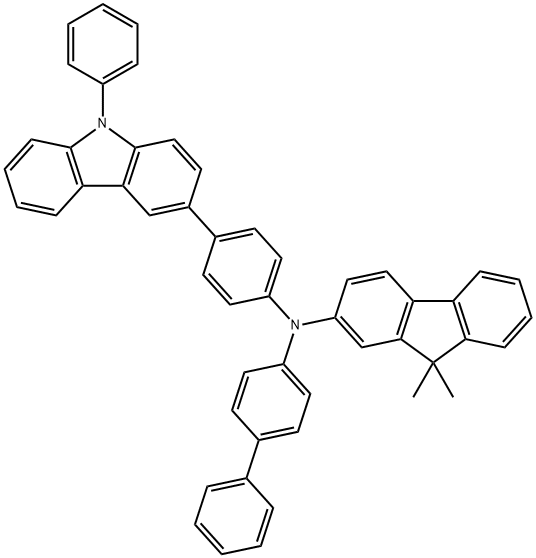OLED Material
CAS.1242056-42-3 HTL
9H-Fluoren-2-aMine, N-[1,1'-biphenyl]-4-yl-9,9-diMethyl-N-[4-(9-phenyl-9H-carbazol-3-yl)phenyl]-
Description
Reviews
| 9H-Fluoren-2-aMine, N-[1,1'-biphenyl]-4-yl-9,9-diMethyl-N-[4-(9-phenyl-9H-carbazol-3-yl)phenyl]- Basic information |
| Product Name: | 9H-Fluoren-2-aMine, N-[1,1'-biphenyl]-4-yl-9,9-diMethyl-N-[4-(9-phenyl-9H-carbazol-3-yl)phenyl]- |
| Synonyms: | 9H-Fluoren-2-aMine, N-[1,1'-biphenyl]-4-yl-9,9-diMethyl-N-[4-(9-phenyl-9H-carbazol-3-yl)phenyl]-;N-[1,1'-Diphenyl]-4-yl-9,9-dimethyl-N-[4-(9-phenyl-9H-carbazol-3-yl)phenyl]-9H-fluoren-2-amine;N-(biphenyl-4-yl)-9,9-dimethyl-N-(4-(9-phenyl-9H-carbazol-3-yl)phenyl)-9H-fiuoren-2-amine;9H-Fluoren-2-Amine,N-[1,1'-biphenyl]-4-yl-9,9-diMethyl-N-[4-(9-phenyl-9H-carbazol-3-yl)phenyl, 99.5%;Biphenyl-4-yl-(9,9-dimethyl-9H-fluoren-2-yl)-[4-(9-phenyl-8a,9-dihydro-4bH-carbazol-3-yl)-phenyl]-amine;N-(4-Biphenylyl)-9,9-dimethyl-N-[4-(9-phenyl-9H-carbazol-3-yl)phenyl]-9H-fluoren-2-amine;N-[[1,1′-biphenyl]-3-yl]-9,9-dimethyl-N-[4-[9-phenyl-9H-carbazol-3-yl]phenyl]-9H-fluoren-2-amine;N-[1,1'-Diphenyl]-4-yl-9,9-dimethyl-N-[4-(9-phenyl-9H-carbazol-3-yl)phenyl]-9H-fluorene-2-amine |
| CAS: | 1242056-42-3 |
| MF: | C51H38N2 |
| MW: | 678.86 |
| EINECS: | |
| Product Categories: | |
| Mol File: | 1242056-42-3.mol |
![9H-Fluoren-2-aMine, N-[1,1'-biphenyl]-4-yl-9,9-diMethyl-N-[4-(9-phenyl-9H-carbazol-3-yl)phenyl]- Structure](https://www.chemicalbook.com/CAS/GIF/1242056-42-3.gif) |
|
| 9H-Fluoren-2-aMine, N-[1,1'-biphenyl]-4-yl-9,9-diMethyl-N-[4-(9-phenyl-9H-carbazol-3-yl)phenyl]- Chemical Properties |
| density | 1.14 |
| storage temp. | Keep in dark place,Sealed in dry,Room Temperature |
| form | powder |
| pka | -2.80±0.40(Predicted) |
| color | white to yellow |
| Safety Information |
| 9H-Fluoren-2-aMine, N-[1,1'-biphenyl]-4-yl-9,9-diMethyl-N-[4-(9-phenyl-9H-carbazol-3-yl)phenyl]- Usage And Synthesis |
| Chemical Properties | Off-white powder |
| Uses |
N-([1,1μ-biphenyl]-4-yl)-9,9-dimethyl-N-(4-(9-phenyl-9H-carbazol-3-yl)phenyl)-9H-fluoren-2-amine (BCFN) is an electron-rich material, with the HOMO energy level of 5.3 eV, the LUMO energy level of 2.2 eV and high hole mobility of 5.43 * 10-5 cm2V-1s-1. As a result, it is used as a hole-transport and hole-injection material in organic light-emitting diodes. BCFN has shown its advantages in improving the hole mobility of polymer-based hole transport layer; lower driving voltage of device, better efficiency, and higher EQE due to exciplex formation by utilizing in EML; and better device lifetimes in the combination of Ir(piq)2(acac) to act as an electron scavenger layer for an reported device. BCFN is a good morphologically stable material with Tg of 125 °C and Td of 375 °C. With a ET of 2.58 eV, BCFN is also a very good charge transporting layer material due to its large band gap (Eg = 3.1 eV) 2 for green, red and white phosphorescent organic light-emitting diodes (PhOLEDs). OLED Device Performance: BCFN increase the hole transport mobility of PVK (pure PVK: 2.09*10-9 V cm-1 S-1; 30% of BCFN in PVK: 9.86*10-7 V cm-1 S-1; 50% of BCFN in PVK: 1.15*10-5 V cm-1 S-1): 1. ITO/PEDOT:PSS (40 nm)/PVK:BCFN (3:7, 20 nm)/BCFN:PFO (x:1-x, 80 nm)/CsF (1.5 nm)/Al (120 nm) Color: Blue BCFN in combination of ET1 to act as EML in forming exciplex and improve device performance: 2. ITO/HIL/HTL/(ET1+P1) or (ET1+BCFN+P1(doped)/ETL/ LiF/Al Color: red Device emission area of 81cm2, and at 1000 cd m-2, the efficiency exceeds 200 lm/W and the EQE exceeds 50 %. lifespan@95: from 71h to 133h BCFN in combination with Ir(piq)2(acac) as electron scavenger layer: 3. ITO/NDP series in BCFN (3wt.%, 10nm)/BCFN(160nm) or BCFN(130nm)+BCFN:Ir(piq)2(acac)(2wt.%, 10nm)+BCFN(20)/ [Ir(TMSBppy)ppy2]:BPTZBC (10 wt.%, 40nm))/ TPBi:Liq (1:1 wt. % ratio, 36nm)/ Liq (0.1nm)/Al (60 nm) Color: yellow Efficiencies are not affected. lifespan@95: from 71h to 133h', 'N-([1,1μ-Biphenyl]-4-yl)-9,9-dimethyl-N-(4-(9-phenyl-9H-carbazol-3-yl)phenyl)-9H-fluoren-2-amine can be used in different application areas as an emissive layer or hole transport layer due the presence of π-conjugated structure and electron-donating/accepting groups. It is suitable to be used in R&D studies such as organic field-effect transistors (OFETs), molecular electronics, sensors, organic photovoltaics (OPVs), and organic light-emitting diodes (OLEDs). |
Share your thoughts
Showing
6
of
0
reviews
Most recent
Top Reviews
Read more
Your rating
Your review *
Name *
Enter your Name
Email *
Enter your Email
Upload Image
Notice: Ensure your image is no larger than 200KB before uploading.
Submit
Contact Us Now
Enter your inquiry details, We will reply you in 24 hours.
Name can't be empty
E-mail can't be empty
Company can't be empty
Phone can't be empty
Phone
Products can't be empty
Products you want
Message can't be empty
Verification code error
Clear
People who viewed this item also viewed

